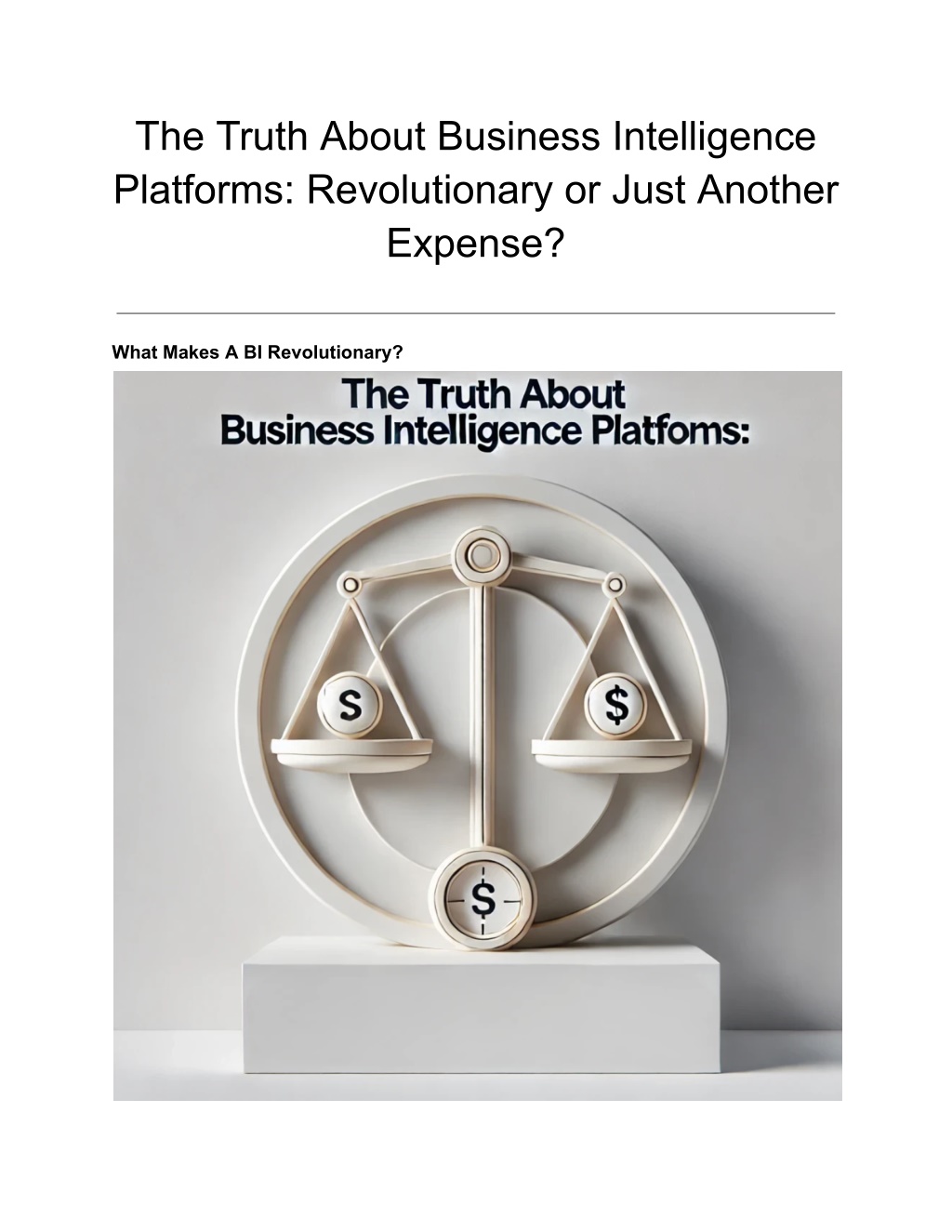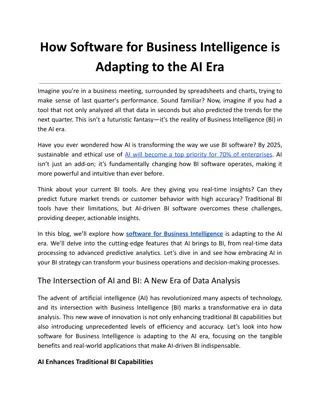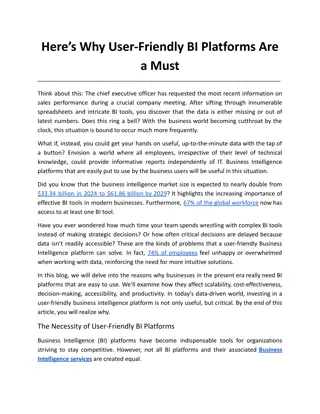
The Truth About Business Intelligence Platforms_ Revolutionary or Just Another Expense_
Explore the intricate dynamics of the Business Intelligence platform in our latest article, where we unravel whether these platforms truly transform business operations or simply add to the bottom line. Through detailed analysis and real-world applic
Download Presentation

Please find below an Image/Link to download the presentation.
The content on the website is provided AS IS for your information and personal use only. It may not be sold, licensed, or shared on other websites without obtaining consent from the author. Download presentation by click this link. If you encounter any issues during the download, it is possible that the publisher has removed the file from their server.
E N D
Presentation Transcript
The Truth About Business Intelligence Platforms: Revolutionary or Just Another Expense? What Makes A BI Revolutionary?
- Automation of Data Collection and Integration The core advantage of a Business Intelligence platform lies in its ability to automate the gathering and integration of data from a myriad of sources. Whether it's pulling from cloud storage, on-premise databases, or directly from third-party applications, a robust BI platform streamlines this process. This automation reduces the labor-intensive task of manual data entry and ensures data accuracy and consistency, which are critical for informed decision-making. By freeing up human resources from these repetitive tasks, businesses can allocate more time to strategic activities that have a direct impact on growth and innovation. - Real-Time Data Analytics and Visualization Capabilities Real-time data analytics, a standout feature of many BI platforms, allows businesses to act swiftly on insights. This capability transforms data into an actionable asset, enabling decision-makers to respond to market changes almost instantaneously. Furthermore, visualization tools within these platforms turn complex data sets into comprehensible visual reports that can be easily interpreted by stakeholders at all levels. This accessibility is crucial for fostering data-driven cultures where strategic decisions are supported by up-to-the-minute data insights. Common Misconceptions About BI Costs Breakdown of Initial vs. Ongoing Costs The initial investment in a Business Intelligence platform can be substantial; however, it's crucial to understand the composition of these costs. Upfront expenses often include software licensing, integration, and initial training. Though these might seem daunting, the ongoing costs typically related to maintenance, upgrades, and possibly additional training are generally lower and can be budgeted more predictably. Moreover, when spread over time, the cost per use tends to decrease significantly, especially as the organization grows and the utility of the BI platform scales accordingly. Comparison of Costs Versus Returns One of the biggest misconceptions about BI platforms is that they are too costly for the value they deliver. To dispel this, consider the return on investment (ROI) from a long-term perspective. For instance: Increased Revenue: By identifying trends and improving customer satisfaction, BI tools can directly contribute to increased sales and revenue.
Cost Reduction: BI platforms often identify inefficiencies in business processes, leading to significant cost savings over time. Risk Mitigation: Enhanced data analysis capabilities help in predicting market trends and avoiding costly missteps. A detailed cost-benefit analysis typically shows that the long-term benefits of implementing a Business Intelligence platform far outweigh the initial and ongoing costs, making it a wise investment rather than just another business expense. By examining these aspects, we can see how Business Intelligence platforms serve as revolutionary tools for organizations willing to invest in their capabilities. The transformation they offer goes beyond mere data analysis, influencing every strategic decision that drives a business forward. Critical Features That Define Effective BI Platforms Integration Capabilities A key feature that sets apart effective Business Intelligence platforms is their ability to seamlessly integrate with an organization's existing systems. This integration capability ensures that data flows smoothly between systems without the need for constant manual intervention or the risk of data silos. An effective BI platform should act as a bridge, connecting disparate systems whether they are CRM software, ERP systems, or various databases and enabling a unified view of all operational data. Seamless integration helps in maintaining data integrity and accuracy, which are crucial for generating reliable insights that drive strategic decisions. The importance of integration in a BI platform cannot be overstated. It directly impacts the ease of use and the speed at which data insights can be generated. Well-integrated systems reduce the complexity of data management and allow analysts and business users to focus more on analysis rather than data gathering. Moreover, a seamlessly integrated BI system can pull real-time data from various sources, providing a holistic view that is essential for agile decision-making. Scalability and Flexibility Data requirements become increasingly sophisticated and massive as companies expand. An effective Business Intelligence platform is not just a tool for today s needs but is designed to scale along with the growth of the company. Scalability in a BI platform means it can handle an increasing amount of data and more complex datasets without performance degradation. This capability ensures that as a company
expandswhether in terms of data volume, number of users, or complexity of queries the BI platform continues to perform optimally. Flexibility is another critical feature of a high-performing Business Intelligence tool. This means the platform can adjust to new business questions as they arise, providing the agility to change data models, add new data sources, or modify reports and dashboards swiftly. This adaptability ensures that the BI system remains relevant and useful as business strategies and market conditions evolve, supporting continuous innovation and improvement. User Experience The user experience (UX) of a BI platform plays an important role in its adoption across all levels of an organization. A user-friendly interface makes it accessible not just to data analysts but also to non-technical users, such as business managers and executive teams. An intuitive design, clear navigation, and interactive elements like drag-and-drop functionalities significantly enhance the usability of Business Intelligence tools. Good UX design in a Business Intelligence platform ensures that users can easily find what they need, understand the data presented, and take action based on insights without extensive training. This widespread accessibility is crucial for fostering a data-driven culture where informed decision-making becomes the norm. Furthermore, when BI tools are easy to use, they encourage frequent use, leading to better familiarity with data insights and more consistent strategic applications. When BI Becomes Just Another Expense Lack of Proper Implementation Common Pitfalls in BI Implementation Effective implementation is crucial for the success of any Business Intelligence platform. When implementation is mishandled, even the most advanced BI tools can become costly and underutilized liabilities. Here are some common pitfalls: 1. Poor Data Governance: Without robust data governance, data can become inconsistent, inaccurate, or even misleading. Effective BI depends on high-quality data, which requires clear policies and procedures for data collection, storage, and access. Poor data governance can lead to distrust in BI outputs, rendering the system ineffective. 2. Inadequate Training: The value of a Business Intelligence platform is only as good as the capability of its users to exploit it fully. Inadequate training can result
in a lack of user engagement and underutilization of the platforms capabilities. Comprehensive training programs are essential to ensure that all users understand how to navigate the system and interpret the insights it generates. 3. Failure to Align BI Strategy with Business Objectives: If the deployment of a BI tool is not aligned with clear business objectives, it can lead to misdirected efforts and wasted resources. It s implementation from the selection dashboards supports specific, strategic business goals. vital of that every to aspect the of BI of metrics design Impact of Implementation Shortfalls The consequences of these pitfalls are significant. They can transform a potentially revolutionary BI tool into just another financial burden. When BI systems are not properly implemented, businesses may continue to make decisions based on outdated or incorrect data, potentially leading to costly strategic errors. Overinvestment in Features Cost Implications of Overly Complex BI Solutions Investing in a BI platform with more features than necessary can lead to significant unnecessary expenses, which can be particularly burdensome for small to mid-sized businesses. Here are key considerations: 1. Complexity vs. Usability: Sometimes, Business Intelligence platforms are packed with advanced features that sound impressive on paper but are rarely needed in everyday operations. This complexity can intimidate users and reduce overall system usability, leading to lower adoption rates. 2. Tailored to Needs: A business should assess its actual needs and select a Business Intelligence tool that is tailored to those needs rather than opting for a 'one-size-fits-all' solution. Customization extensive built-in features, providing a more cost-effective and user-centric solution. 3. Long-Term Cost Efficiency: While it may seem cost-effective in the short term to opt for a platform with extensive capabilities, the long-term costs of licenses, updates, and potentially underutilized features can add up. It's important to conduct a thorough cost-benefit analysis before deciding on the level of complexity needed in a BI tool. options can often substitute for
Conclusion The debate over whether Business Intelligence platforms are revolutionary tools or merely an added expense can be settled by understanding their profound impact on modern businesses. BI platforms transcend traditional data analysis methods by automating data integration, providing real-time insights, and supporting informed decision-making across all levels of an organization. However, their true value is unlocked only through strategic implementation, continuous adaptation, and widespread adoption within the company. For businesses looking to explore the transformative potential of Business Intelligence platforms without an immediate commitment, Grow offers a compelling solution. Grow s Business Intelligence tools are designed to integrate seamlessly with your existing systems, scale according to your evolving business needs, and deliver insights through an intuitive user interface, ensuring that every stakeholder can make data-driven decisions. Interested in experiencing how Grow can revolutionize your data handling and business insights? Take advantage of our 14-day free trial to see firsthand the capabilities and benefits of our platform. Discover more about Grow's features and how they can be tailored to your specific business needs by visiting our page on GetApp: Grow Features & Capabilities GetApp. Don't miss this opportunity to transform your data into one of your greatest strategic assets. Original Source: https://bit.ly/3YEB0U3






















